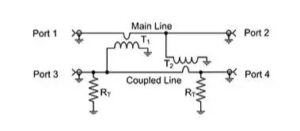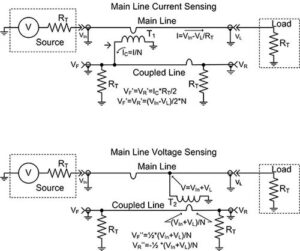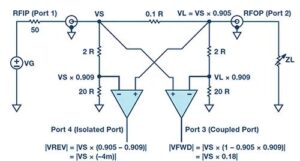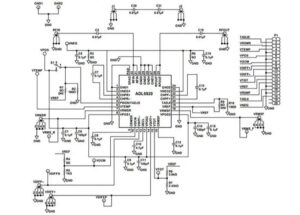In radio frequency (RF) applications such as automotive radar, 5G cellular and Internet of things, the use of RF sources in electronic systems is increasing day by day. All these RF sources need to try to monitor and control the RF power level without causing loss of transmission line and load. In addition, some applications require high-power transmitter output, so designers need to try to monitor the output signal rather than directly connect sensitive instruments to avoid damage caused by the high signal level.
There are also many other challenges: how to determine the characteristics of RF loads (such as antennas) in a wide frequency range; How to monitor the load change and standing wave ratio when the transmitter is in the broadcast state, so as to prevent large reflected power and amplifier damage.
These requirements and challenges can be solved simply by connecting the directional coupler to the transmission line. This method can accurately monitor the RF energy flow in the line and reduce the power level by a known fixed amount. In the sampling process, the directional coupler has little interference with the mainline signal. In addition, it can separate the forward and reflected power, allowing the monitoring of return loss or standing wave ratio, so as to provide load change feedback during broadcasting.
This paper discusses the operation of directional couplers and introduces three topologies and related products launched by ANAREN, M / A-COM, and analog devices. Then, this paper introduces the typical product features in detail and shows the effective use methods.
What is a directional coupler?
A directional coupler is a kind of measuring equipment, which can be connected to the transmission line between RF source and load, such as a signal generator, vector network analyzer, and transmitter. It is used to measure RF power (forward component) from RF source to load and power reflected back from load to RF source (reflected component). If the forward and reflected components are measured, the total power, return loss, and standing wave ratio of the load can be calculated.
The four-port directional coupler can be configured as a three-terminal or four-terminal device (Fig. 1).

Figure 1: schematic symbols of three port (left) and four port directional coupler (right). (image source: digi key electronics)
Usually, the power supply is connected to the input port of the coupler, and the load is connected to the output or transmission port. The output of the coupling port is the attenuated forward signal. The attenuation value is shown in the schematic diagram of three-port equipment. In the three-port equipment, the isolation port has been terminated internally; In a four-port device, the output of the port is directly proportional to the reflected signal. Arrows within schematic symbols indicate component paths. For example, in a four-port configuration, the input port points to the coupling port, indicating that it receives the forward component, while the output port is connected to the isolation port, which is used to read the reflected signal. Port numbers are not standardized and vary from manufacturer to manufacturer. However, the port names of various suppliers are relatively uniform.
The coupler is a symmetrical device, and the connection of each port is interchangeable. For 3 port devices, inverting the input and output ports makes port 3 an isolated port. In a 4 port device, inverting the input and output ports interchanges the coupling and isolation ports.
The output of the coupler is RF signal. The output of the coupling and isolation port is usually connected to a peak or RMS detector, which can generate baseband signals related to forward and reflected power levels. The directional coupler and the correlation detector are combined to form a reflectometer.
In some cases, the back-to-back connection of two directional couplers can form a double-directional coupler to minimize leakage between the coupling port and the isolation port.
Directional coupler specification
The directional coupler has several key characteristics, including bandwidth, rated input power, insertion loss, frequency flatness, coupling coefficient, directivity, isolation, and residual voltage standing wave ratio (VSWR).
Bandwidth: the bandwidth of the coupler represents the frequency range in Hertz. Within this frequency range, the coupler can work within the specification range.
Rated input power: for continuous wave (CW) and pulse input signals, the coupler has the maximum rated input power in watts. This value represents the maximum power that the device can handle without reducing performance or causing physical damage.
Insertion loss: used to describe the power loss caused by equipment access to the main transmission path, in dB.
Frequency Flatness: frequency flatness refers to the amplitude response change of the main transmission path within the specific bandwidth of the equipment. This value is a function of the frequency change of the input signal, in dB.
Coupling coefficient: the coupling coefficient refers to the ratio of the input power to the output power of the coupling port when all ports of the coupler are correctly terminated, in dB. This is one of the main characteristics of the directional coupler. The output of the coupling port is directly proportional to the power level of the through path (from input to output), and the scaling coefficient is a known value. The output of the coupling port can be connected to an oscilloscope and other instruments without the risk of instrument overload.
Isolation degree: when all ports are correctly terminated, the power ratio between the input port and the isolation port is in dB.
Directivity: when all ports are correctly terminated, the power ratio between the coupling port and isolation port is in dB.
For 3 port couplers, two power measurements are usually made: one in the case of normal forward termination and the other in the case of reverse connection of input and output ports. This specification is used to measure the separation degree of forward and reflection components; Generally, the greater the directivity, the better the performance of the coupler. The measured value can only be directly measured by the direction and isolation.
Residual VSWR: the standing wave ratio measured when all ports of the coupler are correctly terminated. This value is used to measure the inherent impedance matching of the coupler.
Directional coupler topology
Directional coupler design can be realized in several ways, of which the three most common topologies are RF transformer, resistance bridge, and coupled transmission line. The RF transformer-based topology uses two RF Transformers (Figure 2). Among them, transformer T1 is used to detect the main line current between input and load. The other transformer T2 is used to detect the voltage to the ground of the mainline. The coupling coefficient depends on the transformer turns ratio n.


Figure 2: directional coupler topology based on RF transformer uses two RF Transformers to detect the forward and reflected components on the main line. (image source: digi key electronics)
By combining the induced voltage of each transformer on the coupling line and adding the results, the theoretical operation analysis of this kind of directional coupler can be carried out (Fig. 3). Vin is the forward voltage and VL is the reflected voltage.

Figure 3: analysis of transformer based coupler by analyzing the voltage of two transformers on the coupling line. (image source: digi key electronics)
In the figure above, in order to calculate the coupling port voltage (VF ‘) and isolation port voltage (VR’) on the coupling line, connect the current detection transformer, but remove the voltage detection transformer. Similarly, the current detection transformer is removed in the figure below, and the voltage detection transformer is connected to the port to calculate VF “and VR”. The coupling port voltage VF can be obtained by adding VF ‘and VF “:
Therefore, the coupling port voltage is equal to the input voltage divided by the transformer turns ratio.
Similarly, the isolation port voltage can be obtained by adding VR ‘and VR “:

This kind of directional coupler has good performance in a wide frequency range. For example, the bandwidth range of macp-011045 of M / A-COM is 5 to 1225 MHz. This transformer based coupler has a coupling coefficient of 23 dB and a rated power of 10 W. The isolation depends on the frequency. When the frequency range is from less than 30 MHz to more than 1 GHz, the corresponding isolation range is 45 dB to 27 dB. The device is packaged in a surface mount package with dimensions of 6.35 mm x 7.11 mm x 4.1 mm, so it is compatible with most wireless applications.
The coupler based on the coupled transmission line is composed of a coaxial cable or printed circuit transmission line. This mechanism closely arranges two or more transmission lines (usually 1 / 4 of the wavelength) so that a small amount of controlled signal power leaks from the main line to one or more coupling lines (Fig. 4).

Figure 4: Example of a dual directional coupler using a coupled transmission line. The length of the transmission line is usually 1 / 4 of the central wavelength of the design frequency band. (image source: digi key electronics)
Input connection port 1, most of the power is transmitted to the load of connection port 2. A small amount of power is coupled to the auxiliary lines connecting ports 3 and 4. Port 3 is a coupling port. The power level of the port accounts for a fixed percentage of the input power. The coupling coefficient can be used to describe the power of the coupling port, which depends on the geometric arrangement of the coupling line. The reflected power is coupled to port 4 (isolated port).
ANAREN’s 11302-20 is a typical coupled transmission line directional coupler with a frequency range of 190 to 400 MHz and a processing power of up to 100 W. The nominal coupling coefficient of the device is 20 dB and the insertion loss is 0.3 dB. The package is surface mount and has a size of 16.51 x 12.19 x 3.58 mm. It can be used to monitor the power level and VSWR measurement of the medium power transmitters. The WeChat official account indicates that the size of the coupler is related to the frequency range, the lower the working frequency, the longer the length. Therefore, it is commonly used in UHF and high-frequency applications, and the corresponding equipment size is small.
The last directional coupler topology is the directional bridge, and the circuit is related to the classical Wheatstone bridge. The adl5920 RMS and VSWR detectors of analog devices adopt this topology (Figure 5).

Figure 5: Simplified schematic diagram of bidirectional bridge used for adl5920 RMS and VSWR detectors of analog devices. When all ports are correctly terminated, the directivity is 33 dB, and the calculation is shown in the figure. (image source: analog devices)
The adl5920 uses a resistance bridge to separate the forward and reflected voltages on the transmission line. As shown in the figure, the theoretical directivity of low-frequency equipment can be calculated when all ports are correctly terminated. The obtained directivity is 33 dB. In the bridge, the output signals of vrev and vfwd are transmitted to the RMS cascade detector (with a dynamic range of 60 dB). The detector output can be read linearly in dB. The third output voltage derived from the difference between the forward output and the reflected output is directly proportional to the return loss, in dB. The bridge based coupler has a frequency range of 9 kHz to 7 GHz and a rated power of 33 DBM (2 W) at a matching load of 50 Ω. When the frequency range is 10 MHz to 7 GHz, the corresponding insertion loss range is 0.9 DB to 2 dB. The device is packaged in a 5 x 5 mm surface mount package with a thickness of 0.75 mm.
Analog devices launched the adl5920-evalz evaluation board for adl5920. This fully configured evaluation board requires a 5 V, 200 Ma power supply. The inputs, outputs and main outputs are connected through 2.92 mm connectors. The following schematic shows the typical connections required for the adl5920 (Figure 6). The evaluation board is an ideal tool to easily try out adl5920.

Figure 6: schematic diagram of adl5920-ealz evaluation board shows the typical connections required for adl5920 bidirectional RMS and VSWR detectors of analog devices. (image source: analog devices)
The directional coupler realized by resistance bridge provides the widest frequency range, which is basically close to direct current (DC). The coupler based on transformer and transmission line has more bandwidth restrictions, but the rated power is greater.
Any of the above devices can extract input power samples for signal monitoring circuits. With the help of traditional instruments such as oscilloscopes or spectrum analyzers to measure the samples, the power level, frequency and modulation system can be determined. The data can also be integrated into the feedback loop to adjust the output to keep within the required range.
The load state can be represented by voltage standing wave ratio (VSWR). The load VSWR of the output port can be calculated by using the outputs of the coupling port and the isolation port (i.e. forward voltage and reflected voltage).

The return loss can be calculated by VSWR:
![]()
Directional coupler is a very useful measuring equipment for RF system designers.
It can not only provide the amplitude proportional view of RF power level but also separate the forward and reflected signal components, which is helpful to the analysis of load characteristics. As mentioned above, there are three common coupler topologies that can provide these outputs, which are not only small in package but also compatible with wireless devices.
